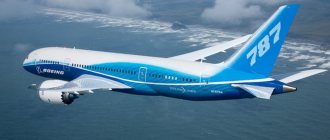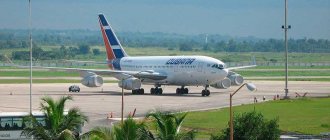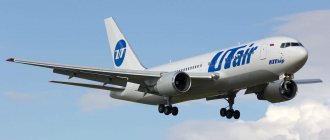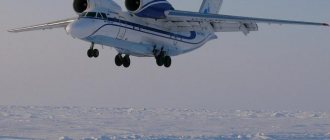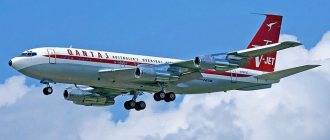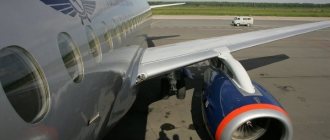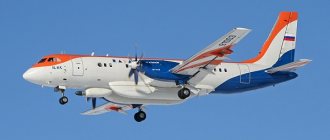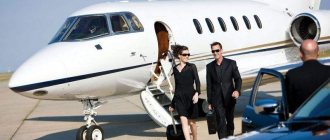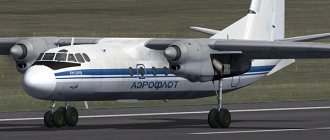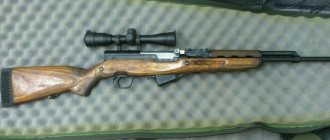In the 70s of the last century, the need for commercial medium-haul transportation contributed to the emergence of the new Yak-42 aircraft.
Yakovlev Design Bureau received an order from Aeroflot to develop a passenger airliner, which will replace the obsolete TU-134 and IL-18. From 1972 to 1975, work was carried out on the YAK 42 series. The first test flight took place in March 1975.
The aircraft was piloted by test pilots Yuri Petrov, Arseniy Kolosov and Yuri Viskovsky (flight engineer). The tests generally went well, but showed insufficient speed for passenger transportation of that time - 680 km/h.
In the mid-seventies, the technically outdated Tu-134 passenger aircraft required urgent replacement. And thanks to the Smolensk (1977-1981) and Saratov (1978-2003) aircraft factories, medium-range three-engine Yak-42 aircraft were produced. The total number of winged machines created was 183, of which two were used in strength testing.
It should be noted that this air machine set nine world records. OKB A.S. Yakovlev was not even involved in multi-passenger airliners. Only military fighters, sports and training models were in development.
The development of the aircraft design itself began in 1972. At that time, the USSR needed a strong, medium-range aircraft that could replace the Il-18 (Ilyushin’s plane) and Tu-134 (Tupolev). The first four prototypes differed from each other with minor modifications. The first specimen had a wing sweep of 11°, the other three had a wing sweep of 23°. And the fourth prototype differed from all others by the presence of a parachute for testing to recover from a spin. Ultimately, for the prototype the choice fell on the third option (the resulting designation was Yak-42). It was distinguished by the presence of twin wheels on each chassis and a swept tail.
Decommissioned Yak-42 - kindergarten
The Yak-42 is an all-metal low-wing aircraft with a semi-monocoque fuselage (the width is similar to the Tu-154 fuselage), three turbojet engines and a tricycle retractable landing gear. There was also a cantilever swept wing and a T-shaped tail with an adjustable stabilizer. It was the Smolensk Aviation Plant that produced the first prototype in 1974, and in 1975 it entered testing. It was led by the famous test pilots Kolosov A., Petrov Yu. and flight engineer Viskovsky Yuri.
The tests were successful, but the aircraft was unable to reach the required flight speed (680 km/h) at an altitude of 8000 meters. Deputy designer E.G. Tsvelev was responsible for all modifications, construction and testing. who, as they say, put both his heart and soul into his work. Advanced designers and engineers (V.A. Sukhorukov, A.G. Khlakin, V.I. Zotov, V.V. Pogulyaev) modified and created many components of the Yak-42 aircraft.
Since the end of 1980, Aeroflot began actively transporting passengers on the Yak-42. The first disaster, which led to the freezing of the production of this aircraft for two years, occurred on June 28, 1982 (tail number USSR-42529). But already in 1988, serial production of modified Yak-42Ds was launched. The flight range and the ability to raise the maximum take-off weight were increased. These models were mainly exported to Cuba and China. The last aircraft was sent in 2003. Due to the cessation of production of technical parts at ZAO Saratov Aviation Plant, the operation of the modernized Yak-42D was stopped.
Ultimately, this aircraft was popular, even despite the fact that the same Boeing 737 and Airbus A319 needed less fuel. However, after the plane crash (09/07/2011), the Yak-42 was completely withdrawn from flights. It was used for long-haul flights and flights between cities.
Thanks to the developments of Soviet aircraft manufacturers, many problems with the contradictory operating characteristics of very poorly prepared airfields, high cruising speeds and high fuel efficiency during flights were solved. It was the Yak-42 that was this development. In comparison with the Tu-154, an innovative solution was implemented to increase weight efficiency, namely, a monolithic composite one was installed to replace the duralumin air intake duct, as well as a threaded wing, which made it possible to remove heavy butt joints and bolts. The built-in ladder is located in the rear of the aircraft (the same as on the Yak-40).
The landing gear is tricycle. The front support is extended along the flow, the main supports are extended across the flow in different directions. And the retraction, release and braking mechanism of the chassis operate hydraulically. The wheels are similar to those of the Tu-154 aircraft. Double class hydraulic system - main and emergency. Two drive pumps and an AC pumping station are responsible for the pressure in them. Drive pumps are located in engine No. 1 and No. 2 and are responsible for the main hydraulic system. And the NS-46-3 (pumping station), which operates from the main system, and the NS-55 direct current station, produced from batteries, are responsible for the pressure in the emergency hydraulic system.
Yak-42 VIP
Both systems ensure the operability of slats and flaps (RP-71 steering gears), landing gear extension, rearrangement of the stabilizer, retraction of spoilers and wheel braking.
There are practically no differences in power supply between the Yak-42 and Tu-154, except for one detail: power and redundancy are much less. The initial system is a three-phase voltage, which saturates the secondary 36 V systems.
The main elements of the system are:
- Three generators (three-phase GT30NZhCh12). They produce constant revolutions.
- Generator GT40PCh6 (from APU)
- 2 rectifiers. Convert three-phase voltage to direct voltage (from 208 V to 27 V).
- Transistor disposable (static) converter POS-1000A. The main task is to convert direct voltage (27 V) into single-phase alternating voltage (115 V).
- Transformers TS320SO4B in the amount of two pieces. Reduce three-phase voltage.
- Static converter PTS-800AM. Since it is three phase, it is used for emergency power supply.
- Converter PTS-25, static, three-phase. Used for autonomous power supply of the reserve AGR-74 attitude indicator.
- Two rechargeable batteries (nickel-cadmium, 20NKBN-40). They power consumers and converters in case of failure of generators and rectifiers.
Navigation equipment consists of the Alder-1 complexes (very similar to the Pizhma complex), equipment for high-altitude high-speed units (VSP1-6), RSBN, 2 automatic radio complexes, and the KURS MP-70 landing system.
The fuel system consists of three tanks, one in the center section and two on the sides. Each of them holds more than six thousand kilograms of fuel and has a reserve alarm. The left and right side caisson tanks feed engines No. 1 and No. 3. Accordingly, the middle caisson feeds the second engine (using two pumps). Also, the middle tank feeds the APU using a separate pump. In the event of an emergency failure of fuel pumps or engines, it is quite possible to combine all fuel lines.
Although the engines do not have thrust reversers, braking during the run is provided by wheel brakes, spoilers and a low landing speed, just like the An-24.
At this time, the approximate wear and tear of the entire fleet of Yak-42 aircraft is about fifty percent. This flying machine was never able to replace the Tu-134, which is still in partial operation to this day. In total, 183 different series and modifications of the Yak-42 were designed. At the same time, during the period of the 70s and 80s, this aircraft was very modern. But due to the 1982 plane crash in Belarus and the collapse of the Soviet Union, the future fate of the Yak-42 was frozen.
History of creation
The development of the Yak-42 medium-haul airliner started in the early 70s of the last century. The aircraft was intended to replace the obsolete Il-18 (with piston engines) and Tu-134 aircraft.
For the new aircraft, a concept with three turbojet engines located in the tail section was initially adopted. Two units were placed in pylons, and the third was installed in the fuselage and was equipped with an air intake located in the fork.
For this reason, a T-shaped empennage design was used, with horizontal control surfaces located at the top of the fin.
Several prototypes built in the mid-70s featured different wing sweeps and the presence of additional components (for example, a parachute for spin recovery).
Based on the test results, the third prototype, equipped with a swept tail and reinforced main landing gear with twin wheels, received approval. In this form, the Yak-42 aircraft was shown to the public during the Le Bourget air show in 1977.
The aircraft entered production in the same year, but the official commissioning and deployment of the airliner for passenger flights took place only at the end of 1980.
Two years later, the Yak-42 aircraft board 11040104 crashed due to a design defect in the horizontal tail control system.
During the investigation into the cause of the disaster and the development of a new unit, production stopped.
Modernized aircraft began to be built only in 1984, and four years later production began of an improved version of the Yak-42D, which allowed greater take-off weight and provided a longer flight range.
The last aircraft were assembled in 2003. A total of 183 copies of the Yak-42 and 42D were manufactured (the main production of the vehicles was established at the Saratov Aviation Plant).
Development[edit]
Three exhausts of the Lotarev D-36 and the rear ladder are deployed.
In 1972, Yakovleva began work on a short- and medium-range airliner capable of carrying 100–120 passengers. It was intended to replace the Tupolev Tu-134 aircraft, as well as the Ilyushin Il-18, Antonov An-24 and An-26 turboprop airliners. Although the new airliner had to operate from relatively small airfields while maintaining good economy, since many Soviet airports had been upgraded to accommodate more advanced aircraft, it did not need to have the same ability to operate from grass strips as the smaller Yakovlevsky Yak-40 . This requirement led to the largest, heaviest and most powerful aircraft designed by Yakovlev,[3][4] until the even larger MC-21 flew in 2022.[ edit
]
Initial design proposals included a straight-wing airliner powered by two Solovyov D-30 turbofans and resembling an enlarged Yak-40, but this was rejected as it was considered uncompetitive compared to Western airliners running on high-bypass turbofans. Yakovlev settled on a design with three new Lotarev D-36 three-shaft bypass turbofan engines, which would provide 63.90 kN (14,330 lbf) of thrust. Unlike the Yak-40, the new airliner would have swept wings. [4] [5]
First of three prototypes with rake wing
11 degrees and registration number
USSR-1974
made its first flight on March 7, 1975.
It was followed by a second prototype ( USSR-1975
) with a
wing
and aerofoil.
a cabin with 20 rows of windows instead of 17 in the first prototype and a third prototype ( USSR-1976
) equipped with improved anti-icing devices. [6] [7]
Design
When developing the Yak-42, the designers of the Yakovlev Design Bureau tried to combine the ability to operate from unprepared runways, fuel efficiency and the ability to maintain high cruising speeds.
To reduce the weight of the aircraft airframe, monolithic air intake channels made of composite materials were used. The wing plane was made monolithic and had no parting lines that made the structure heavier.
The Yak-42 aircraft uses a nose-mounted landing gear with a rotating front strut, which is released along the air flow. The main posts extend to the left and right sides in a direction perpendicular to the flow.
The drives of the landing gear release and retraction mechanisms and the front strut rotation are hydraulic. The main and emergency systems are installed to supply fluid.
Wheel brakes equipped with disc mechanisms are connected to the system lines.
When the hydraulic system is running, the rudder booster is powered from it. In case of failure, the steering wheel is controlled manually. The ailerons and elevators are controlled by the pilots' hands.
The working pressure in hydraulic systems reaches 170 atm. n is created by two pumps installed on the junction boxes of the side engines. In case of failure of the main pumps, the system is powered by two electrical stations - alternating current (from the on-board network of the Yak-42 aircraft) and direct current (from batteries).
In addition to the landing gear, slats, flaps, and spoiler flaps on the surface of the wing and stabilizer are driven by hydraulics.
To control the stabilizer, it is possible to use the emergency and main systems, each of which drives a separate screw drive unit.
In normal mode, the Yak-42 aircraft stabilizer is deflected from the main system by rotating the screw of the worm mechanism.
In emergency situations, the stabilizer is controlled by turning the nut.
The primary electrical system of the Yak-42 has three phases and an operating voltage of 112/208 volts (at a frequency of 400 Hz). Using transformers and rectifiers, the voltage is converted into alternating current 36 volts (400 Hz) and direct current 27 volts.
Three 30 kW generators (installed on a turbojet engine) are used as current sources. There is also a 40 kW parking generator and two batteries. If the main generators fail, all aircraft consumers can be powered from batteries through voltage converters.
The fuel supply on the Yak-42 aircraft is located in three tanks installed in the center section and on the sides of the fuselage. The tanks have the same capacity and hold 6170 kg of fuel. When the reserve is 870 kg, the reserve balance alarm is activated, and at 320 kg, the missed approach remainder alarm is activated.
Each tank feeds its engine using two pumps. To supply fuel to the auxiliary unit, a tank in the center section and a separate pump are used. If this pump fails, the unit can be powered by the mid-engine pumps.
In emergency mode, the tanks are combined using taps, which are automatically opened when the missed approach reserve alarm is triggered.
Three-shaft turbojet engines D-36, developed at the Progress Design Bureau (Zaporozhye), were used as power plants. The engine weighs 1124 kg and is capable of developing a thrust of 6500 kgf in emergency mode.
In this mode, the Yak-42 aircraft is capable of taking off on two engines. In cruising mode at an altitude of 8000 m, the thrust is within 1600 kgf.
The standard passenger cabin has two rows of three-seater seats. The first row of seats on the plane has increased legroom for passengers. For entry and exit, a door and a sliding ladder located in the rear fuselage are used.
The drive of the ladder mechanisms on the Yak-42 is made from an emergency hydraulic system. In case of emergency, passengers can leave the Yak-42 through six emergency exits located on the sides. There are bathrooms at the beginning and end of the salon.
The cabin has a partition installed between the 6th and 7th rows of seats.
Emergency exits are located next to it. Because of this, the passenger seats in row 7 are always empty.
A second row of emergency windows is available between rows 13 and 14. To ensure unhindered egress, the backs of the thirteenth row seats are locked. There are variants of the Yak-42 aircraft with a cabin for 100 passengers, divided into business class and economy class.
Business class seats are located between the bulkheads. There are a total of eight double seats for passengers in this class. The rest of the interior follows the standard interior layout.
Air show layout
The Yak-42 aircraft differs according to the air show project into two types:
- Economy class for 120 seats.
- Two-class uniform for 100 seats: 84 economy and 16 business class.
In both configurations, the two salons are separated from each other by special partitions. The total cabin width is 3.6 m, which is less than average by the standards of passenger airliners.
Technical characteristics in comparison with competitors
| Yak-42 | Tu-134A | IL-18 | |
| Empty weight, kg | 28960 | 27960 | 35000 |
| Permissible take-off weight, kg | 53500 | 43000 | 64000 |
| Length, mm | 36380 | 37100 | 35900 |
| Height, mm | 9830 | 9020 | 10170 |
| Swing, mm | 34880 | 29000 | 37420 |
| Fuselage diameter, mm | 3600 | 2900 | 3500 |
| Wing area, sq. m | 150,0 | 127,3 | 140,0 |
| Cruising speed, km/h | 810 | 900 | 625 |
| Maximum flight range, km | 2300 | 1900 | 6500 |
| Ceiling, m | 9600 | 11900 | 10000 |
| Passenger capacity, persons | 120 | 76 | 120 |
Best places
The most comfortable seats at the air show will be in business class, due to the greatest distance between the front and rear seats and the reclining seat. If you are eating in economy, choose seats in the 7th row - due to the doors in front of the row, the legroom will be increased.
If you are afraid of unforeseen situations, sit in the 13th or 14th row, right between them there is an emergency exit.
You should not sit in the first and last row of an airliner, even in business class, as they are close to the bathrooms and doors to the vestibule, which will constantly slam. The first row is also inconvenient because there is a partition in front of it.
If you want to select good places more precisely:
- Study the plane diagram;
- Do not occupy places near technical rooms (toilets, kitchens, etc.)
- Do not take seats that do not recline.
- Ask an airline representative for help in choosing, they will definitely give you advice.
Features of operation
The Yak-42 airliners supplied for export had a two-seater cabin, which was new for the USSR aircraft industry. A similar result was achieved by repeatedly testing various combinations of instrument panels and consoles on stands and selecting convenient combinations of automatic and manual drives.
During development, the designers tried to ensure a minimum amount of work on ground handling and routine repairs, which was supposed to reduce aircraft downtime.
To load luggage and cargo, both standard containers and conventional loading could be used.
In order to simplify operation from 3rd class airfields, an autonomous ladder was used on the Yak-42.
Links[edit]
- ^ a b c d Gunston and Gordon 1997, p. 198.
- Gunston, 1997
- ↑
Gordon, Komissarov and Komissarov 2005, p. 311. - ^ a b Gunston and Gordon 1997, p. 194.
- ↑
Gordon, Komissarov and Komissarov 2005, pp. 311–312. - ^ ab Gordon, Komissarov and Komissarov 2005, pp. 312–314.
- Gunston and Gordon pp. 196-197.
- ^ a b Gunston and Gordon 1997, p. 195.
- ^ abc Taylor 1982, p. 241.
- Yakovlev OKB: History of the design bureau and its aircraft von Efim Gordon (author), Dmitry Komissarov (author), Sergei Komissarov (author) ISBN 1-85780-203-9 ISBN 978-1-85780-203-0
- ↑
Gordon, Komissarov and Komissarov 2005, pp. 314–315. - ^ a b Gunston and Gordon 1997, p. 197.
- ↑ Flight International,
January 30, 1982, p. 208. - ^ ab Gordon, Komissarov and Komissarov 2005, p. 315.
- ^ ab Gordon, Komissarov and Komissarov 2005, p. 316.
- ^ ab Taylor 1999, pp. 227–228.
- ↑
Gordon, Komissarov and Komissarov 2005, pp. 317–318. - ↑
Gordon, Komissarov and Komissarov 2005, p. 318. - ↑
Gordon, Komissarov and Komissarov 2005, pp. 319–320. - ↑
Gordon, Komissarov and Komissarov 2005, pp. 320–321. - Thisdell and Seymour Flight International
July 30-August 5, 2022, p. 47. - Accident description for USSR-42529 at the Flight Safety Network. Retrieved February 2, 2016.
- Accident description for USSR-42536 at the Flight Safety Network. Retrieved February 2, 2016.
- "Yak-42 crashes". CBC. Archived from the original on January 16, 2014. Retrieved January 15, 2014.
- Accident description for USSR-42351 at the Flight Safety Network. Retrieved February 2, 2016.
- Description of accidents for the B-2755 on the Air Safety Network. Retrieved February 2, 2016.
- Accident description for RA-42390 at the Aviation Safety Network. Retrieved February 2, 2016.
- Accident description for UR-42334 at the Aviation Safety Network. Retrieved February 2, 2016.
- Description of the CU-T1285 accident in the aviation safety network. Retrieved February 2, 2016.
- Accident description for UR-42352 at the Aviation Safety Network. Retrieved February 2, 2016.
- Accident description for RA-42434 at the Aviation Safety Network. Retrieved February 2, 2016.
- Gladniker, David. "An Incomplete Guide to Using an Airfoil". m-selig.ae.illinois.edu
. Retrieved April 16, 2022.
- "Aeroflot completes year of Yak-42 operation". Flight International
, January 30, 1982, p. 208. - Gordon, Efim, Dmitry Komissarov and Sergei Komissarov. Yakovlev OKB: History of the Design Bureau and its Aircraft
. Hinckley, UK: Midland Publishing, 2005. ISBN 1-85780-203-9. - Gunston, Bill and Efim Gordon. Yakovlev aircraft from 1924
. London, UK: Putnam Aviation Books, 1997. ISBN 1-55750-978-6. - Taylor, Joyne W.R. Jane's Airplanes of the World 1982–83
. London: Jane Yearbooks, 1982. ISBN 0-7106-0748-2. - Taylor,
Michael J. H.
World Guide to Aircraft and Systems , 1999/2000
. London: Brassey's, 1999. ISBN 1-85753-245-7. - Tisdell, Dan and Morris, Rob. "World Airliner Census." Flight International
, Vol. 194, No. 5650, August 21 - September 3, 2022 ISSN 0015-3710. pp. 24–47. - Tisdell, Dan and Seymour, Chris. "World Airliner Census." Flight International
, Vol. 196, No. 5694, July 30 - August 5, 2022 ISSN 0015-3710. pp. 24–47.
Mark on history
At the end of the 80s, work began on the creation of a modernized Yak-42A, based on the 42D model. The new aircraft was supposed to be equipped with an extended fuselage and economical Progress D-36 engines.
The first prototype was built at the end of 1992 and was designated Yak-142. It was planned to create a family of cars with passenger compartments designed to carry from 39 to 120 people.
Serial production was not launched due to the bankruptcy of the Saratov Aviation Plant. A single production aircraft has been built and is operated by aviation.
In 1993, a project was developed for the Yak-242 aircraft, equipped with two PS-90A12 engines and using elements of the Yak-42 airframe.
In terms of its technical characteristics, it was supposed to occupy an intermediate position between short-haul and medium-haul vehicles. The project was not implemented.
To date, Yak-42 and 42D aircraft continue to be operated on domestic routes. At the same time, the operation of some of the vehicles was suspended in accordance with the results of the investigation into the accident on board RA-42434.
Due to the bankruptcy of the Saratov Aviation Plant (the main manufacturer of aircraft), support for equipment in operation has been discontinued. Because of this, the future prospects of the Yak-42 are vague; most likely, the aircraft will be taken out of service and written off in the near future. As of March 20, 2015, only 38 aircraft remained in flying condition, and as of August 2022, only 35.
ъY-42— NDMYU KH MELMNTSKHU LYUHM yushPNTKNRYU, YNRNPYU B PEIKÜLE ME MSFDUKYUYAE. dNYARYURNVMN MYUGBYURE KH'E RNR TUYR, VRN MU YY-42 SYARYUMNBKEMN DEBRE LHPNBSHU PAINPDNB. b NDMNL KH MHU YAYULNKER, OPEDMYUGMYUVEMMSHI DK AKHFMKHU BNGDSMSHU KHMKHI, AEG ONYUDYKH OPENDNKEK PUYAYARNJMHE NR LNYAYBSH DN UYUAYUPNBYAYU. x SCHRN REL SDHBHREKEMEE, VRN DN YANGDYUMKH ETSN OPEDEYARBEMMKHYU - yY-40 PYUGPYUANRYULH LMNTSNLEYARMSHU OYYAYUFHPYAYKHU YYULNKERNB THPLYU BNNAYE ME GYUMKHLYUKYUYAE. yYUY KHGBEYARMN, nya yu.ya.YNBKEBYU YAOEZHHYUKHGHPNBYUKNYAE, B NYAMNBMNL, MU OPNEIRKHPNBYUMHH SVEAMSHU, YAONPRHBMSHU X BNEMMSHU YYULNKERNB-HYARPEAHREKEY. bPEL NR BPELEMKH YANGDUBUKHYAE KH MEANKEKHE OYYAYUFHPYAYKHE LYUHMSH.
eYE B MYUVYUKE 1933-TSN ASHK YANGDYUM yukhp-5, B 1944-L - yY-8 DK LEYARKH OYUYAYUFKHPNB, GYUREL ONBKHKHYAE VERSHPEULEYARMSHI yY-12 X DEYARKHLEYARMSHI yY-16 B 1 947-L. sFE DK OEPBSHU OYYAYUFHPYAYHU YYULNKERNB nya ASHKYU UYUPYUREPMY OPEDEKEMN OPNYARYU, KETSYYU X SDNAMYU B NAYAKSFKHBYUMHH YNMYARPSYZHH I YANBEPEMMSHHLH TNPLLYULH. schRKH YAOEZHTHTHVEYAYKHE NYANAYEMNYARH OEPEMEYAKH MU OEPBSHI PEYURKHBMSHHI OYUYAYUFHPYAYKHI YYULNKER DK LEYARMSHU YUBKHYUKHMKHI y-40, OPHMEYAKHI TKHPLE LHPNBNE OPHGMYUMKHE. rPEUDBHTSYUREKEMSHI PEYURKHBMSHI KYUIMEP I YAYUKNMNL MU 32 OYUYAYUFHPYU H DUKEMNYARECH ONKERYU 2200 YL ONKSVHK BSHIANYSCH NZHEMYS YAOEZHYUKHYARNB B PUGMSHU YARPYUMYUU. ECN OPHLEMEMKHE ONGBNKHKN GYULEMHRE MU BMSRPEMMKHU KKHMKHU SYARYUPEBKHE RHOSH - BEREPIUMNB - kX-2, xK-12, xK-14.
b NYRYAPE 1966-TSN MU YY-40 ASHK BSHONKMEM OEPBSHI BSHKER (KERVHYH-HYAOSHRYUREKH nya y.k.yNKNYANB X b.oERPNB). pSYNBNDHK PUANRYULH ON YANGDYUMKHCH, ONYARPNIYE KH DNBNDYE y-40 GYULEYARKHREKE TSKYUBMNTSN YNMYARPSYRNPYU e.ts.yuDKEP, YNRNPSHY PUANRYUK B NYA YA 1932-TSN X GYUMKHLYUKYA E E B BNEMMSHE TsNDSH OPNEIRKHPNBYUMHEL TPNMRBNNTsN KHYARPEAHREK yY-3 KH ETSN LNDKHTHYUZHKHI. pSYNBNDYARBN KERMSHLH HYAOSHRYUMHOLH NYASYYARBKK GYULEYARHREKE TSKYUBMNTSN YNMYARPSYRNPYU y.a.aEYKHPAYUEB. KERMSHE HYAOSHRYUMKH ONPSVHKKH, B RN BPEL PYUANRYUBJELS MUVYUKEMKHYNL NRDEKYU KERMSHU HYAOSHRYUMKHI y.l.tsYUKHMYAINLS. nM DNATSNE BPEL PUANRYUK GYULEYARKHREKEL TSKYUBMNTSN YNMYARPSYRNPYU ON KERMSHL HYAOSHRYUMKHL, YU YAEIVYUYA - BEDSYKHI KHMFEMEP ON y-42.
b 1960-U GUYYUGSH MU ETSN SHYYAONPR ONЪBKHKHYAE KH YARPYUM BYAU YNMRKHMEMRNB. KHRYUKH, OEPBYU OPHNAPERYU YY-40, NPTsYUMKHGNBYUKYU ONYUG BSHYANYKHU SHYAOXYURYUZHNMMSHU YUVEYARB SHHRNI LYUKHMSH. oHKNRKHPSELSHI PSYAYAYHL (KERVKHY-HYAOSHRYUREKE l.ts.gYUBEKNB) X KHRYUKEMYAYKHL KERVKHYYULH YAYULNKER BOEPBSHE YANBEPEKHK OEPEKER HG pKHLYU B yuBYARPYUKKHCH. lYUPPSR OPENDNKEKH AEG YUYHU-KHAN ONKNLNYH NRYUGNB. tPYUMZHSGYAYKHI FSPMYUK “YUBHYUYAENM LSCHTSCHGKHM” B YUOPEKE 1970-TSN NRLEVYUK: “Y-40, NPHTSKHMYUKEM ON GYULSHYAKS, ON YABNHL KERMSHL YUPYYUREPHYARKHYUL H PUGLEPYUL. MU GUYUDE TYURHVEYAYH MER YAPYUBMHLNTSN I MHL YAYULNKERYU. ETsN LNFMN KKHE YANONYARYUBHRE I MEINRNPSHLH YULEPHYUMYUMYAHLH OPNEYRYULH, YNRNPSHE ASDSR PEYUKHGNBUMSH ME PUMEYE, VEPEG MEYAINKEIN KER.”
ъY-40 ASHK OEPBSHL PEYURHBMSHL OYYAYYUFHPYAYHL YYULNKERNL nya, BMEYALHL MU LEYARMSHE KKHMXX YNLTNPR KH YAYNPNYARE. b OEPKHND 1966-TSN ON 1980-I ONYARPNEMN YABSHYE 1000 SHYGELOKPNB. xG MHU 122 SHYYAONPRKHPNBYUMSH B 18 YARPIUM. bSHYANYU MUDEFMNYARE KH SMEPTSNBNNPSFEMMNYARE YYULNKERYU NAEYAOEVKHBUKH RPH RPDD yukh-25. ъY-40 -OOEPBSHI NREVEYARBEMMSHI YYULNKER, YAEPRHTKHZHPNBYUMMSHI ON MNPLYUL KERMNI TSNDMNYARKH yayu FAR-25 X yuMTSKKHH - BCAR. pYUANRSH ON YAEPRHTHYUZHHH yY-40 SYAINPHKH NPTSYUMHYUZHHCH YUBHYUZHNMMNTSN PETSKHYARPYU B MUYEI YARPYUME, OPKHMYRKHE MNPL KERMNI TSNDMNYARKH (mktsa) X NYABNEMHE MUYEI OPNLSHKEM MNYARECH PUDYU LYUREPHYUKNB KH YUTSPETSYURNB, YANNRBERYARBSCHYKHU GYUOYUDMSHL MNPLYUL. pYUANRYULH ON NYASYYARBKEMKHCH ONYARYUBNY YY-40 GYU PSAEF KH ETSN YAEPRHTHYUZHHEI PSYNBNDHK GYULEYARKHREKE TSKYUBMNTSN YNMYARPSYRNPYU yu.yu.keBKHMAYKHU. YaUELYU y-40 X RNFE I OPTLSHL YPSHKNL ONKSVKHKYU PUGBHRKHE B ANKEE YANBEPEMMNI PEYURKHBMNI LYUHME DK AKHFMKHU LYUTSKHYARPYUKEY-Y-42, PYYAYAVHRYUMMNNI MU 120 OYUYAYU FHPYAYKHU LEYAR. TsNBNPЪR, RÜYNE PEEMKHE Yu.Ya.YINBKEBS ASHKN MYUBEMN SYAOEMNI SHYAOXYURYUZHHEI y-40.
GDEYAE, NVEBKHDMN, ONDISOYUKN KH RN NAYARRNREKEYARBN, VRN OPILNE YPSHKN HLEER NRMNYAHREKEMN ANKEKHI, VEL YARPEKNBKHDMNE, YNSHTTTKHZHEMR ONDZELMNI YAKSH, VRN MYUOP'LSCH NRPYUF YUERYA B SHYNMNLXX RNOXBYU OPH YAPYUBMHREKEMN MEANKEHU YAYNPNYARU KH DUKEMNYARKH ONKERYU. ndMUYN OPH ANKEE LNYMSHU DBKHTSUREKYU YAKEDSER PUYAYAVKHRSHBURE KH MU ANKEE BSHYANISCH YAYNPNYARE, VETSN SHTTEYRKHBMEE LNFMN DNYARHVE OPH YARPEKNBKHDMNL YPSHKE. y SHRNLS, YANAYARBEMMN, yINBKEB KH OPHYEK, MN MEYAINKEIN ONGFE. yu ONYU, B MYUVYUKE 1974-CN, PEVE KBYU N yY-42 HLEMMN I OPTLSHL YPSHKNL. lHMKHYARP TsPUFDUMYAYNI YUBKHYUZHKH a.asTSYUEB KHVMN OPEDYARYUBKHK SHYAIKHGMSHI OPNEIR yY-42 B ZHY, TsDE NM ASHK NDNAPEM k.aPEFMEBSHL, VRN B RN BPEL KHLEKN PEYUCHYEE GMYUVEMHE. ONYAKE SRBEPFDEMKH OPNEYRYU H I SVERNL RNCN, VRN LUYER OKYUMEPYU B MYURSPYUKEMSCH BEKHVHMS SFE ONYARPNEM, B nya OPHMЪKKH YALEKNE PEEMHE N YANYPYUYYEMHH YAPNYNB BSHOSYAYU KUIMEPY M Yu 1 TsND. b PEGSKERYURE BYAU SYAKHKHI Y YNMZHS 1974-TSN YAYULNKER SFE BSHYURHKH KH YAANPNVMNTSN ZHEUYU.
b OEPBSHI ONKER B LUPRE 1975-CN YAYULNKER ONDMЪKH GUYAKSFEMMSHY KERVKHY-HYAOSHRYUREKE yPYAYEMKHI yNKNYANB, KERVKHY-HYAOSHRYUREKE chPKHI oERPNB X ANPRKHMFEMEP chPKHI bKHYAYNBYAYKHI. хЯОШРУМХЪ OPNUNDHKH MNPLYUKEMN, MN YAYNPNYARE WITH YAYULNKERY I OPTLSHL YPSHKNL ASHKYU BYAE-RYUYKH MEDNYURRNVMNI: LYUYAKHLYUKEMYYPEIYEPYAYU MU BSHYANRE 8000 L - 6 80 YL/V. b YABGKH I ShchRHL XG LHMKHYAREPYARBU TSPUFDUMYAYNI YUBKHYUZHHH ONYARSOKHKN RPEANBYUMKHE - DK PEYUYRKHBMNTSN OYYAYUFKHPYAYNTSN YYULNKERYU AKHFMKHU LYUTSKHYARPYUKEY FEKYUREKEMYU YP EIAYEPYAYU YAYNPNYARE ONPJDYU 700-800 YL/V. rntsdyu-rn b nya PEHKH - YARPNHRE YAYULNKER YAN YARPEKNBKHDMSHL YPSHKNL 30╟.
MNBSHI OPNEIR BSHONKMKHKH DNBNKEMN ASHYARPN, Kh SFE B MYUVYUKE 1975-TSN yY-42 OPKHMЪK GMYYINLSHE BYAEL MYUL UYUPYUREPMSHE NVEPRYUMKH - MHGYN PUYAONKNFEMNE YARPEKNBKHDMNE YPSHKN, RPH YNLOYUYRMSHU DBKHTSYUREK B PUINME UBNYARYU, BSHYANYNPYYAONKNFEMMSHI YARPEKNBKHDMSHI YARYUAHKHGYURNP. KERVHYH-HYAOSHRYUREKH ONYAKE OEPBSHU FE ONKERNB NRLERHKH BSHYANYSCH SCHMEPTSNBNPSFEMMNYARE YYULNKERYU, ECN NRKHVMSHE OKHNRYUFMSHE YUVEYARBU, SARNIVHBNYARE H KETSINYARE AE GASYAREPMNTSN SOPYUBKEMKH, SDNAYARBN PUYAONKNFEMKH OPKHANPNB KH YUTSPETSYURNB SOPYUBKEMKH. jRSPLUM-HYAOSHRYUREKE BVEYAKYUB USDYNB ONDRBEPDHK YANBEPEMYARBN OPKHANPNB YAYULNKERNBNFDEMH, NAEYAOEVKHBUCHYKHU AEGNOYUMNYARE ONKERNB ON OPKHANPYUL MNVECH KH B YAKNFMSHU LERENSYAKNBKHU.
pYUANRYULH ON ONYARPNIYE, DNBNDYE H KERMSHL HYAOSHRYUMKHL y-42 PSYNBNDHK GYULEYARHREKE TSKYUBMNTSN YNMYARPSYRNPYU b.ts.zhBEKEB, YNRNPSHI B SHCHRKH PUANRSH BKNFHK YNKNYAYUK EMSCH ShchMEPTSKHCH X GMYUMH. BEDSYKHLH KHMFEMEPULYH ON YY-42 B PUGMNE BPEL ASHKKH b.b.ONTSSKYEB, b.h.gNRNB, y.ts.ukYUYKHM, ch.yu.oKHMNBYAYKHI, y.l.ySDPYNB, b.y.yaSUNPSYNB X r.yu. bNKYNBU. SFE B 1982-L MU YY-42 NYABNHKH LYuYAAS LYUPPSRNB, X KYUIMEP PETSSKЪPMN YSPYAKHPNBUK MU LMNTSKHU KHMKHU, YABGSHBYUBKHU DEYAYRYKH TsNPNDNB YARPIUMSH, YU RUYFE X MU LE FDSMYUPNDMSHU KHMKHU ON RPYYAYYUL lNYAYBYU - aEPKHM, KEMKHMTSPYUD - UEKEYAKHMYKH, lNYAYBYU - oPYUTSIU. BYAETSN GYU ONKRNPYU TSNDYU I MYUVYUKYU SHYYAOXYURYUZHHH MU YAYULNKERYUU SHRNTSN RHOYU OEPEBEGKH NYNKN ONKSLHKKKHNMY OYYAYUFHPNB. Yu.Ya.YNBKEB, BYAETSDU I ANKEHL SBUFEMHEL NRMNYAKHBKHIYYY KERVKHYYUL-HYAOSHRYUREKL, YAVKHRYUK, VRN DK ONDMIRKH YUBRNPKHRERYU YYULNKERYU PAINPDSH DNAFMSH SYARYUMYUBKKHBYUR EYAY PUGMSHHLH KERVHYULH. ON ETSN YNLYUMDE B PENPDMSHU ONKERYUU y-42 OKHKNRKHPNBUKH sh.o.yMQTsKHMKHVEB - KERVKHY-HYAOSHRYUREKE kkhkh, n.ya.onKSDN - KERVKHY-HYAOSHRYUREKE tsNYamkhkh qiu X KERVKHYH-KHAOSH RYUREKH nya b.ts.lSUHM, ch.yu.ebYNB, b .x.kQTSSYKHM X n.yu.aSKSHTSKHM.
th YAEPKHIMNLS OPNKHGBNDYARBS OPHYARSOKHKH YALNKEMYAYKHI, YU GYUREL H YYUPURNBYAYKHI GYUBNDSH. oEPBSHI ONKER I OYUYAYUFHPYULH YY-42 YANBEPHK 22 DAYUAP 1980 TsNDYU, “XIAOB” B JAPNY, MYULEVEMMSHI TsEMYAYNL. MUVYUKN SHYYAOXYURYUZHKH ASHKN BEYAELYU SYAOEMSHL, B NRKHVHE NR RFEFKNTSN xK-86, MYUVYUBYETSN OEPEBNGYKH OPYURKHVEYAYKH NDMNBPELEMMN, ╚YS╩ ME RPEANBUKNYAE M NBSHU ONKNYA X PSKEFMSHU DNPNFEY, ONSHCHRNLS TSENTSPYUTKH ONKERNB ASHIARPN PUYAHPKYUYAE. rPYUTSEDH OPNKHGNKYU 28 KhChM 1982 TsNDYU OND AEKNPSYAYAKHL TsNPNDNL lNGSHPE. with YAKEDNBYUBYETSN MU SCHJEKNME yY-42 I ANPRNBSHL MNLEPNL 42529 oSKYNBYaYNTsN he kemkhmtspyudyayntsn stsyu BMEGYUOMN PYUGPSKHKYA SGEK YPEOKEMKH YARYUAHKHKYURNPYU X OPNKHGNYEK EC N NRPSHB. BYAE MUUNDIKHEYA MU ANPRS KCHDH ONTSHAKH. schRYU YURYUYARPNTY YARYUKYU YAEPEEGMSHL SDYUPNL ON NYA. ONKERSH BYAEU MYUNDYKHUYA B SHYYAOXYURYUZHHH y-42 ASHKKH MELEDKEMMN OPEYPYUYEMSH, MYVYUKNYAE PUYAYAKEDNBUMHE. VRN OPKHBEKN Y PUGPSIEMKHCH BKHMRYU LEUUMKHGLYu SOPIUBKEMKH YARYUAHKHGYURNPNL - MYUPSYEMKHE MNPL REUMKHVEYAYNI SCHYAOXYURYUZHKH, HKH YNMYARPSYRNPYAYU NYHAYU, YU LNFER ASHRE, YAKN FHKKHYAE NAE OPHVKHMSH - DNYARNMHEL TSKYUYAMNYARKH RYU KH ME YARYUKN. MU DNATSKHE ONKRNPYU TSNDYU ╚YH╩ GYUYARSHKH OND APEGEMRNBSHLH VEUKYULKH MU YARNMYUU AYUGNBSHU YUSCHPNONPRNB. YaYUGYUKHYAE X KHVMSHE MEOPKHGMEMMSHE NRMNYEMH, YAKNFHBHEYA LEFDS RNTSDUYMHL lHMHYARPNL qiu yayap ASTSYUEBSHL X yu.ya.YINBKEBSHL. ONBRNPMSHI BBND YAYULNKERYU B SHYYAOXYURYUZHCH OPNYEK SFE RHUN, AEG UBNYNTSN NYABEYEMKH B OPEYAYAE. ONFYUKSI, I REU ONP YAYULNKER RYU X MUUNDHRYA MELMNTSN B REMH. dK GYUBEPYEMKH TsPSYARMNI RELSH OPHDERYA YAYUGYURE, VRN I REU ONP OPNHGNYKN EYE YAELE ROFEKSHU KERMSHU OPNHYAYAYARBKHI I YAYULNKERYULH YY-42, NDMUYN BYAE NMH ASHKH YABGYU MSH I MYUBKHTSYUZHNMMSHLKH OHKNRYUFMSHHLKH NHAYYULH SHCHYHOYUFEI, YAYUL YAYULNKER ANKEYE ME ONDBNDHK MH PUGS.
YAKSVYUKHYAE H OPNHYAYARBHЪ, YNRNPSHE KHMYUVE, YUY YSPEEGMSHLH, ME MYUGNBEYE. RYUY, NDMYUFDSH, S GYUYUMVKHBUCHYETSN MUANP BSHIANRSH YY-42 BMEGYUOMN OPNKHGNYEK NRYUG BYAU RPEU DBKHTSUREKEY. schYHOYUF PUGBEPMSK LYUHMS H ONOSHRYUKYA DNRJMSRE DN YUSCHPNONPRYU BSHKERYU B OKYUMKHPPNBYUMXX I BSHIANRSH 7000 LERPNB. mu BSHIANRE 3000 LERPNB SDIUKNYAE GYUOSYARHRE NDHM DBKHTSUREKE, MU 2000 ≈ EYE DBYU. ONYAKE ONYYUDYKH BSHYAMHKNYAE, VRN SHYKHOYUF ME VKHRYUK YUPRS NAYGYUREKEMSHU OPNBEPNY, X ANPRLEUUMHY GUASHK BYKCHVHRE ONDIYUVKHBUCHYKHE RNKOKHBMSHE MUYANYASH. yNTsDU RNOKKHBN HG RNOKHBMSHU YYYSLSKRNPNB BSHPYUANRYUKNYAE, DBKHTSYUREKH NYARYUMNBHKHYAE - NAPYUGNBYUBKHEYA B RNOKHBNOPNBNDYU OPH ONMKHFEMXX DYUBKEMKH TSYUGNBNGDSSM SHE OPNYIKH OPEORYARBNBUKH MUONKMEMHCH RNOXBMSHU YYYSLSKIRNPNB YAYULNRAINL. th YAVYUYARECH, OPHVHMS NYARYUMNBYKH DBKHTSYUREKEY NAMYUPSFHKH BNBPEL. oPH BGKERE KH YUSCHPNONPRYU bMSYNBN SCHYHOYUF SYYYUKHMYAINTSN yY-42 DNANFHK N ONFYUPE MU ANPRS KH MELEDKEMMNI ONYAUDYE. ONYYUDYS SHYHOYUF OPNKHGBEK MUYARNKEIN MELEDKEMMSCH, VRN B YAOYE... GYUASHK BSHOSYARKHRE YUYAYAKH. MEYALNRP MU ╚OPNONKGYUMHE╩ OH AERNMMNI boo, NANKNYAE AEG YAEPEEEGMN ONYARPYUDYUBKHU. yYARYURKH, YAPYUAYURSHBYUMHE DYURVHYU ONFYUPMNI YAHTSMYUKHGYUZHHH NYUGYUKNYAE KNFMSHL.
eYE NDHM YAKSVUI, BEYAEL KEYARMN UYUPYYUREPKHGSCHYKHI YNMYARPSYZHCH YY-42, OPNKHGNYEK B NDMNL KH YUBYYUGYAYKHU YUSCHPNONPRNB. oPH GYUUNDE B SYAKNBKHU YAKHKEMNI ANKRYUMYKH ANYNBNTSN BERPYU, SHYHOYUF “OPNLYUGYUK” X I NONGDYUMKHEL MUVYUK LYUMEBP SUNDU MU BRNPNI YPSTS. ONYAINKEYS BERPNBSHE SYAKNBKHЪ ME KHGLEMKHKHYAE, YNLYUMDHP OPKHMJK PEYEMKHE ON SUNDA MU GYUOYUMNI YUSCHPNDPNL. yYuYNBN FE ASHKN HGSLKEMKHE REUMKHYNB, DU KH YAYULKHU KERVKHYNB, YNTsDU ONYAKE ONYYUDYKH B YUSCHPNONPRS AEYAKYUM NMH SBHDEKH... NRNTsMSRSCH BBEPU KH DETNPLHPNBYUMMSCH GUYNMZHNBYS YP SHKYU! NYUGSHBUERYA, OPH PUGBNPNRE I YAHKEMSHL YPEEMNL YYULNKER GYUZHEOHK YPSHKNL GELKCH...
THPLYU KHL.YU.YA.YNBKEBYU HLEKYU YNKNYAYUKEMSHI LMNTsNKERMKHI NOSHR, MYUNOKEMMSHI OPH YANGDYUMHH BNEMMSHU, YAONPRHBMSHU H LYUKSHU OYAYAYUFHPYAYHU YYULNKERNB, BYAETSDU NRKHVYUB FUCKING BSHYANINI BEYANBNI YSKERSPNI. b MNBSHU SYAKNBKHU, OPH SHTTEYRKHBMNL HYAONKEGNBYUMKHH DNYARKHFEEMKHI YANBPELEMMNI YUSCHPNDHMYULHYH, LEUUMHYH, LYUREPHYUKNBEDEMKH ShchRKH BNGLNFMNYARKH MYULMNTSN PUYAHPHKH JE. nyanane BMHLUMKHE B PYUGPYUANRYE y-42 ASHKN SDEKEMN SLEMEEMHCH BEYAYU X SBEKHVEMKHCH OPNVMNYARKH YNMYARPSYZHHH. RYUY, DK YAMKHFEMKH BEYU OKYUMEPYU (RPEAANBYUMKH Y GYUOYUYAS OPNVMNYARKH NYRYUCHRYA MEGSHAKELSHLH) YPSHKN MNBNTSN YAYULNKERYU BSHONKMKHKH MEPYUGZELMSHL, VRN ONGBNKKHKN DNAH RAY MYUKHANKEE PUZHNMYUKEMNTSN PUYAOPEDEKEMH LERYUKKYU ON BAYEL YAEVEMHLL PYUGLUYUYPSHKYU. yNKHVEYARBN LEYAR, TsDE BNGLNFMSH YNPPNGHHH LERYUKKYU H RPEYKHMSH, DNBEDEMSH DN LHMHLSLYU. MU YAYULNKERE OPHLEMEMSH MNBSHE ON YNMYARPSYZHKH, OPEDEKEMN OPNYARSHE, MYUDEFMSHE H KETSYKHE GUYPSHKYKH, DUCHYKHE TSYUPYUMRKHH B NAEYAOEVEMHH BSHYANYKHU MEYASYKHU YABNIYARB YPSHKYU.
EYE NDMHL OPHLEPNL SDYUVMNTSN YNMYARPSYRKHBMNTSN PEYEMKH LNFER ONYAKSFKHRE YUMYUK BNGDSUNGYUANPMHYU YAPEDMETSN DBKHTSUREK, YNRNPSHI SYARYUMNBKEM B UBNYARNBNI VYUYARKH T CHGEKFU. schRNR BNGDSUNGYUANPMKHY OPH NAYEI DKHME NYNKN 7 L X DHYULERPE 1300 LL, KHLECHYKHI YAKNFMSCH KHNTsMSRSCH TNPLS, BSHONKMEM B BHDE LNMNKHRMNI DERYUKH. yNMYARPSYRKHBMN NM OPEDYARYUBKJER YANANI RPSAS YAN YAREMYULH HG RPEUYAKNIMNTSN YAREIKNOKYARHYU, MYULNRYUMMNL MY JAOEZHYUKEMNL YARUMYE. BEYA RYUNTSN BNGDSUNGYUANPMKHYU OH YAPYUBMEMHCH I DPSTSHLH, ONDNAMSHLH, SDUKNYAE YAMKHGHRE OPHLEPMN MU 70 YTS, SBEKHVHB OPH SCHRNL ETSN SHYAOXYURYUZHNMMSHY YAPNY YAKSFASH. yu REUMNKNTSKH KhGTSNRNBKEMKH ETSN OPH ShchRNL MYULMNTSN SOPNYARHKYUYAE. b PEGSKERYURE ONKHYAINB THPLE SDIUKNYAE MUIRKH MUKHANKEE SHTTTEIRKHBMSHE OPNKHGBNDYARBEMMSHE OPHELSH, ONGBNKKHBHE NORKHLYUKEMN PYUGPEHRE KHGBEYARMSHE OPNRKHBNPEVKHBSHE RPEAN BYUMKH Y BEYAS, OPNVMNYARKH YAYULNKERYU KH ETSN DNATSNBEVMNYARKH.
MU SHYYAONPRMSHU LYUHMYU AY-42 BOEPBSHE B OPYURKHYE NREVEYARBEMMNTSN YYULNKERNYARPNEMH MU OYUYAYUFHPYAYNL YYULNKERE OPEDSYALYURPHBYUKYUYAE BYAETSN KHIE DBSULEYARMYU YUA KhMU OKNRNB. schRNR BYUPHYUMR ONЪBHKYA B PEGSKERYURE LMNTSNNYYURMNI OPNBEPYKH MU YAREMDUU PUGKKHVMSHU YNLONMNBNNY OPKHANPMSHU DAY YHRYNB KH OSKERNB, NORHLYUKEMSHU I RNVYKH GPEM ХЪ MYUKHANKEYEI PYUZHNMYUKEMNYARKH PYUGLEYEMKH NPTsYUMNB SOPYUBKEMKH, MYUKHANKEE SDYUVMNTSN YANVERYUMKH YUBRNLYURKHVEYAYKHU SYARPNIYARB KH PSVMNTSN SOPYUBKEMKH. b KHRNTSE ASHK BSHAPYUM YAYULSHI SHTTEYRKHBMSHHI BYUPKHYUMR, YNCDU LNFMN ASHKN NANIRKHYAE AEG LRSPLUMYU H ANPRHMFEMEPU. nDMuYN BSHYANYU SHTTTEIRKHBMNYARE SHYYAOXYURYUZHH OYUYAYUFHPYAYNTSN YYULNKERYU GYUBHYAHR ME RNKEIN NR KERVKHYNB, MN X BYAU MUGELMSHU YAKSFA - DHYAOERVEPNB, PELNMRMKHYNB, ONC PSGVHYNB. tsKYUBMNI GYUDYUVEI PYUGPYUANRVKHYNB ASHKN NAKETSVHRE KHU RPSD DN LKHMHLUKEMNTSN NAZELYU. pYUGPYUAYURSHBU YAYULNKER, YNMYARPSYRNPYAYKHI YNKKEIRKHB, BNGTSKYUBKELSHI yu.ya.YINBKEBSHL, YARPELHKYA ON BNGLNFMNYARKH SLEMEHRE NAZEL PUANR ON PELNMRS X NAYAKSFKHBYUMH CH LYUKHMSH, YANYPYURKHRE MEOPNKHGBNDHREKEMSHE OPNYARNKH YY-42 MU GELKE. RYU ASHKYU OPEDSYALNRPEMYU ONTSPSGYU AYUTSYUFYU OYUYAYUFHPNB X PYUGKHVMSHU TsPSGNB B YARYUMDUPRMSHU YNMREEMEPIUU X AEG MKHU.
ANPRNBNI RPYUO, OPHLEMEMMSHI MU YAYULNKERE, YADEKYUKH MEMSFMSHLH MUGELMSHE RPYUOSH, YNRNPSHE YARYURKH, MU YUSCHPNDPNLYU 3-CN YKYUYAYU H ME OPEDSYALNRPEMSH ON URURS. yu BEDE B SCHRNL "OSYARVYE" - GMYUVHREKEMNE SBEKHVEMKHE YUBRNMNLMNYARKH LYUKHMSH. ANKESCH SCHYNMNLKHCH DUK X OEPEUND REUMHVEYAYNTSN NAYAKSFKHBYUMKH YY-42r MU SHYAOXYURYUZHCH YAYULNKERYU "ON REUMHVEYAINLS YANYARNMHCH". schryu MYUKHANKEE PUZHNMYUKEMYYAHYARELY ONYAREOOEMN BBNDHKYUYAE BN BYAE ONDPYUGDEKEMKH cbt. nVEME BYUFMN EYE X RN, VRN ON YAPYUBMEMHCH YAN YABNHLH OPEDEYARBEMMKHYULH yuM-24, y-40 X rs-134, y-42 PYYAUNDNBUK GMYUVHREKEMN LEMEYER RNOXBYU MU NDHM OYYAYUFKHPN-Y KHKNLERP, VRN BEKN Y YASYYYARBEMMNLS YAMHFEMHCH YAAEYARNHLNYARH OEPEBNGNY. x GDEYAE, B OEPBSCH NVEPEDE, YAKEDSER YAYUGYURE N GYULEVYUREKEMSHU rpd YNMYARPSYZHHH bKYUDHLHPYU kNYRYUPEBU d-36, YAOPNEIRKHPPNBUMMNL B nya yu.hBVEMYN B gYUONPNFEEE.
oEPBSHL NYNASHL OPHGMYUNL d-36 YAKEDSER MYUGBYURE BSHIANYSCH YAREOEME DBSUINMRSPMNYARKH - 5.4 (S DPSTSKHU ONDNAMSHU DBKHTSYUREKEY - KHIE 2). yPNLE SCHRNTSN, DBKHTSUREKH NRKHVYUCHRYA MUDEFMNYARECH, ANKEHL PEYASPIANL X NVEME BSHYANYNI SHYNMNLHVMNYARECH - 0.65YTs/V MU BGKERMNL PEFHLE X 0.35YL/V - MU YPEIYAE PAYNL GMYUVHREKEMN YAMHFEM BSL DBKHTSUREK. "rHUHL" YADEKYURE y-42 SDYUKNYAE EYH AKYUTSNDYUP BMSRPEMMELS NYANANLS SLNONTSKNYYUCHYELS SYARPNIYARBS MU LNRNTsNMDNKYU - LMNTSNYAKNIMSHU OEPTNHPPNBUMMSHU BYARYUBNY, I DEKYUMMSHU HG LERYUKKYU H YAREIKNOKYARHYU. ON SPNBMCH ESLYU d-36 NRBEVUER YAYULSHL FEYARYHL RPEANBYUMHL LEFDSMYUPNDMSHU YARYUMDUPRNB. mN X ShchRNTsN LYUKN: DBKHTSUREKH ShchRKH ONVRKH AEGDSHLMSH. schYNMNLKHVEYAYKHI YPHGHYA YAHKEMN SDYUPKHK ON YAYULNKERMNLS OYUPYS YUBKHYINLOYUMKHI. ME NANYEK NM YARNPNMNI X YY-42 .
lMNTSKHE LYUKHMSH BYARYUKH MU OPHYNK: GUYNMVHKYA PEYASPYA DBKHTSYUREKEY, YUTSPETSYURNB, MER RNOXBYU... x REL ME LEMEE EYARE ONDBHFYKH B KSWSCH YARNPNMS. YuBKHYYNLOYUMKH "ASHYNBN-YUBKHYU", MUOPHLEP, MU YAETSNDMYUMKHI DEME PUYAONKYUTSUER NDKHMMYUJURECH ANPRYULKH yY-42. n RNL, YYUYYU YARYUBYU YADEKYUMYU MU SHCHRKH YAYULNKERSH, PYYAYAYUGYUK TSEMEPYUKEMSHI DHPEYRNP YUBKHYUNLOYUMXX yuKEYYUMDP yuYINB. BYAE SYAKHKH PSYNBNDYARBU nyun B AKKHFUIEEE BPEL ASDSR MYUOPYUBKEMSH MU BNGNAMNBKEMHE X PUYAYHPEMHE OYYAYUFHPYAYHU OEPEBNGNY YAYULNKERYULH y-42 MU BMSRPEMMKHU PEIYUU B P YUDHSYAE 2500 YL. YaEIVYUYA FE yY-42 HG aSHYNBN KERYUCHR KHIE B yuMYUOS X LYUTSMHRNTsNPYAY.
OHKNRYuFMN-MYUBKHTSYUZHHNMMNE NANPSDNBYUMHE yY-42 YANYARNKKN HG MYUBKHTSYUZHNMMNTSN YNLOKEYAYU ╚nKEYUYU-1╩ (YaUNDMNTSN I PYUGPYUANRYUMMSHL B RN FE BPEL DKЪ xK-86 YNLOKEYANL ╚ohFLYU╩), YNLOKEYAYU BSHIANRMN-YAYNPNYARMShu OYUPYULERPNB byao-1-6, pyaam ╚bEEP-l ╩, DBSU YUBRNLYURKHVEYAYHU PUDHNYNLOYUYANB, YAHYARELSH KHMYARPSLEMRYUKEMNI ONYUDYKH “yspya lo-70╩, ONGBNKYEI YANBEPIURE ONYUDYS ON NREVEYARBEMMSH YSPYAN-TSKKHYA YUDMSHL YAHYARELYUL yao X YUMYUKNTSKHVMSHL GYUPSAEFMSHL YAHYARELYUL ILS, YU RUYFE ONKER B YUBRNLYURHVEYAYNL PEFHLE ON YAHTSMYUKYUL LYUNB VOR, DNOKEPNBAYNTSN KHGLEPKHREK YAYNPNYARKH STSKYU Yamnyu dhyaya -016 X LERENPNKNTSKHVEYAYNI pkya “tsPNGYU-42”. BLEYARE I ANPRNBNI YAKHYARELNI SOPYUBKEMKH YAYUS-42, SCHRNR YNLOKEYA ONGBNKKYANBEPIURE ONYUDYS ON II YURETSNPKHH ICAO. ONYAINKAYS B yayap RNTSDU EYE ME ASHKN MH NDMNTSN YUSCHPNDNPNLYU, OPKHTSNDMNTSN DK OPHELYU YAYULNKERNB ON YURETSNPKHH ICAO III yu, BYAE ShRN NANPSDNBYUMKHE ASHKN BONKME YANBPELEMMSHL X DNYARYUR NWMSHL. YAKHKNBYU SYARYUMNBYU YYULNKERYU YANYARNKYU HG RPEU RSPANBEMRKHKRNPMSHU RPEUBYUKEMSHU DBKHTSYUREKEY d-36 b.yu.kNRYUPEBU RCNI ON 6500 YTSYA X BIAONLNTSYUREKEMNI YAHKNBNI SYARYUMNBYKH ryu-6b, NAEYAOEVHBYUCHYEI YUBRNMNLMSHI BNGDSMSHI GYUOSYAY DBKHTSYUREKEY, OPNTsPEB KH BEMRKHKJHCH YAYUKNMYU X YUAKHMSH MU GELKE, ONDUVS MU ANPR SHKEYRPNSCHMEPTSKHH PUAN RS TsKHDPNMYYANYAMNI YARYUMZHHH B YAKSVUE NRYUGYU DBKHTSUREK B ONKERE. IYULYU BSHIANYYU YAPEDH NREVEYARBEMMSHU OYYAYUFHPYAYKHU YYULNKERNB RCTSNBNPSFEMMNYARE - 0.36, DEKYUKYU BGKER I YNPNRYKHU (NR 2000 L) ONKNYA AEGNOYUMSHL OPH NRYUGE NDMN CN DBKHTSUREK MU KCHANL SCHRYUOE BGKERYU. aKYUTSNDYUP SHCHRHL DBKHTSYUREKL, y-42 DUFE SYARYUMNBHK PJD LHPNBSHU PEINPDNB B YABNEL YKYUYAYAE (6 KHG 8 - OH YAYNPNONDZELMNYARKH). oPUBDU, YAEPEEGMSHL MEDNYARYURYNL DBKHTSUREKEY d-36 ASHKN NRYASRYARBKHE PEBEPIAHBMNTSN SYARPNYARBU, YU YANGDYUMKHE BMEMETSN PEBEPIYU, YUY S RNCN FE Y-40, DUBUKN ANKE BNI OPNHTSPSH ON MUDEFMNYARKH BEYANBSHL OYUPYULERPYUL, ONSHRNLS DK RNPLNFEMKH ╚YANPNNY BRNPNLS╩ NYARYUBHKH RNKEIN YAONIKEPSH RNPLNGYU YNKEYA.
MU DYUMMSHI LNLEMR BYAETSN VERSHPE YY-42 HG NDKHMMYUDZHURKH TsNRNBSH Y PETSSKPMNI SHYAOXYURYUZHHH.
ndMUYN SFE B ShchRNL TsNDS BYAE BNGDSSMSHE YASDU ASDSR NRPELNMRKHPNBYUMSH, NANPSDNBYUMSH YAYUKNMYULH AKHGMEYA-YKYUYAYU H ONYARYUBKEMSH MU PETSSKЪPMSHE KHMXX. aSHYNBZhSH RBEPDN SBEPEMSH B OEPYAOEIRKHBMNYARKH SHYAOXYURYUZHKH y-42, YNRNPSHY, ON HU LMEMKHCH, EYE LNFER DUFE DURE TNPS "aNHMTsS-737-200". YaETsNDM YAREPFMEBNI TSPUFDUMYAYNI OPNTsPYULLNI nya ЪБКЪРЯЪ OYUYAYUFHPYAYKHI YYULNKER y-42 KH ETSN LNDKHTHYUZHHH. I 1991-CN PSYNBNDYARBN PUANRYULH ON y-40 X y-42 NYASYYARBKJER TSKYUBMSHI YNMYARPSYRNP yuKEYYAEI tsyuYURNBHV pYUUKHLAYUEB. b MUYARNYEE BPEL yY-42 X yY-42d B GYUBHYAHLNYARH NR RPEANBYUMKHI SHYYAOXYURYUMRNB NANPDSDSCHRYA OYYAYUFHPYAYHLH YYUKNMYULH DK OEPEBNGYH NR 39 DN 120 OYUYAYU FKHPNB, BYKCHVYU YUKNM YYULNTSN BSHYANYNTSN YKYUYAYU I PYUGKHVMSHLH BYUPKHYUMRYULH ASTERMN-YSUUNMMNTSN NANPSDNBYUMKH I BNGLNFMNYARECH NAEYAOEVEMKH TsNPVHL OKHRYUMKHEL. lNDHTHYUZHHH :
| ъY-42 | OEPBUYAEPKHIMYU LNDKHTKHYUZHKH. |
| ъY-42d | LNDKHTHYUZHKH I SBEKKHVEMMSHL GYUOYUYANL RNOKKHBYU. |
| ъY-42е-кк | HYAOSHRYUREKEMSHI YAREMD DK DBHTSYUREKEY, DELNMYARPHPNBUKYA B 1991TS. MU oYUPHFYAYNL YUBKHYUAYUKNME, NYAMYUYEMMSHI BHMRNBEMRKHKRNPMSHL DBKHTSUREKEL glia oPNTSPEYAYA d-236 ON OPYUBNLS ANPRS. |
| ъY-42t | LNDKHTKHYUZHKH DK YUSCHPNTNRNYAZELYKH, NYAMYUYEM DBSL ANKEHLH ONDIPSHKEEBSHLH YNMREIMEPYULH, B YNRNPSHU, NVEBKHDMN, PYUGLEYUCHRYA SHCHKEIRPNORHVEYAYHE DYURVHYH. |
| ъY-42л | LNDEPMHGKHPNBUMMYU BEPYAKH YY-42d. |
| ъИ-142 ( ъИ-42у ) | BYUPHYUMR YYULNKERYU AY-42d I ANKEE YANBEPEMMSHL NANPSDNBYUMHEL, ONBSHYEMMSHL YNLTNPRNL X LEMEHL SPNBmel LSLYU. |
| cru: |
| lNDHTHYUZHH | ъY-42 |
| pYUGLUU YPSHKYU, L | 34.88 |
| dKKHMYU YAYULNKERYU,L | 36.38 |
| bSHYANRYU YAYULNKERYU,L | 9.83 |
| OKNYYUDE YPSHKYU, L2 | 150.0 |
| I love it, JC | |
| OSYARNTSN YYULNKERYU | 28960 |
| LYUYAHLYUKEMYU BGKERMYU | 53500 |
| bMSRPEMMEEE RNOKHBN, JC | 18500 |
| RHO DBKHTSUREK | 3 rpdd oPNTSPEYA (kNRYUPEB) d-36 |
| rЪTSYU, Ym | 3 U 63.74 |
| yPEIYEPYAYU YAYNPNYARE, YL/V | 810 |
| oPUYRHVEYAYU DUKEMNYARE, YL | 3900 |
| DYUKEMNYARE DEIYARBKH, YL | 1300-2300 |
| oPUYIRKHVEYAYKHI ONRNNKNY, L | 9600 |
| ShYKHOYUF, VEK | 2-3 |
| ONKEGMYU MYUTSPSGYU: | 120 OYYAYUFKHPNB KHKH 12800 YC TsPSGYU |
| bottom. KhMTNPLYUZHKH: |
| VEPREF "YINBKEB AY-42" yMKhTSYU "gYUDNPNFMNBYU a. “pYUDKHNNANPSDNBYUMKHE YYULNKERYU Y-42 KH ETSN KERMYU SHYAOXYURYUZHKH” tNRNTsPYUTKHH: | ъЯ-42 ╘ CPH Aviation |
| ъЯ-42 ╘ Gary Watt — AirteamImages | |
| ъЯ-42 ╘ yuxiaobin | |
| ъЯ-42 ╘ Oliver Brunke | |
| oYYAYYUFHPYAYKHI YYUKNM | |
| oPKHANPMYU OYUMEKE |
IWELSH:
| ъY-42 |
bYUPHYUMRSH NYPYYAYH:
| ъY-42 yushPNTKNRYu, 1982 TsND |
| YaOHYANY HYARNVMKHYNB: |
| yPSHKE pNDHMSH. hPKHI YaEPTSEEEB. yushchPNASYA DK LEYARMSHU KKHMKHI yPSHKE PNDKHMSH. EBTSEMKHI YUDKEP. yYYYANGDUBUKYA yY-42 l-uNAAH. dLHRPHY YNKEYAMHY. IYULSHI MEBEGSVKHI YPSHKE PNDHMSH. I. YNBKEB. aKKHFMELYUTSKHYARPUKEMSHI, YAYNPNYARMNI: ъY-42 NYABYUKHBUER MNBSHE BNGDSMSHE KKHMXX bHYRNP aEKEB. oYAYAYUFHPYAYHE YYULNKERSH LHPYU REUMKHYU - LNKNDEFH. ya.YNBKEB "YaOPKHMREP" MU YAPEDMEI DKHYARYUMZHHH yBKHYUZHNMMSHY YAOPYUBNVMKHY MU Avia.ru. ъY — 42 oYuYaYUFKhPYAYKHI YYULNKER DK YUBKHYUKKHMKHI LYUKNI OPNRFEMMNYARKH |
sTSNKNY MEAYU. 2004
Cabin of the Yak-42
Similar
An-24 Engine. Dimensions. Range of flight. Practical ceiling. Story
Tu-154 Speed. Dimensions. Weight. Capacity. Fuel consumption. Story
Yak-40 Engine. Dimensions. Capacity. Range of flight. Practical ceiling. Story
An-2 Engine. Dimensions. Story. Range of flight. Service ceiling
Tu-144 Engine. Dimensions. Range of flight. Practical ceiling. Story
IL-96 Speed. Dimensions. Capacity. Story. Load capacity
IL-62 Engine. Dimensions. Range of flight. Practical ceiling. Story
IL-18 Engine. Dimensions. Range of flight. Practical ceiling. Story
IL-14 Engine. Dimensions. Story. Range of flight. Service ceiling
An-14 Pchelka Speed. Dimensions. Weight. Capacity. Story. Load capacity
An-148 Speed. Price. Dimensions. Story. Capacity. Fuel consumption
Yak-42 Speed. Dimensions. Capacity. Fuel consumption. Story. Range of flight
Tu-114 Speed. Dimensions. Weight. Capacity. Story. Load capacity
Yak-12 Speed. Dimensions. Weight. Story. Capacity. Load capacity
An-3 Engine. Dimensions. Range of flight. Service ceiling
IL-114 Engine. Dimensions. Range of flight. Service ceiling
Yak-52 Engine. Dimensions. Range of flight. Service ceiling
Tu-334 Speed. Dimensions. Weight. Story. Capacity. Range of flight
Tu-134 Speed. Dimensions. Capacity. Fuel consumption. Story. Range of flight
IL-86 Engine. Dimensions. Range of flight. Service ceiling
Tu-204 Engine. Dimensions. Range of flight. Practical ceiling. Fuel consumption. Price
Tu-104 Engine. Dimensions. Story. Range of flight. Service ceiling
Su-29 Engine. Dimensions. Range of flight. Practical ceiling. Story
Su-31 Speed. Price. Dimensions. Story. Load capacity
Tu-124 Speed. Dimensions. Capacity. Weight. Story. Range of flight
Su-26 Engine. Dimensions. Range of flight. Service ceiling
An-10 Speed. Dimensions. Weight. Story. Capacity. Load capacity
An-140 Speed. Price. Dimensions. Capacity. Fuel consumption. Story
MiG-8 Duck Engine. Dimensions. Story. Range of flight. Service ceiling
Be-30 / Be-32K Engine. Speed. Dimensions. Range of flight. Service ceiling
An-38 Speed. Dimensions. Weight. Story. Capacity. Range of flight
Be-103 Speed. Price. Dimensions. Weight. Story. Capacity
IL-103 Engine. Dimensions. Capacity. Load capacity. Range of flight. Service ceiling
LK-1 (NIAI-1 Plywood-2) History. Dimensions. Engine. Range of flight
ANT-20 Maxim Gorky Speed. Story. Engine. Dimensions. Range of flight
Tu-110 Engine. Dimensions. Range of flight. Practical ceiling. Story
Yak-58 Speed. Dimensions. Weight. Story. Range of flight. Service ceiling
Aviatika-MAI-890 Engine. Dimensions. Speed. Range of flight. Service ceiling
Yak-50 Speed. Dimensions. Story. Range of flight. Service ceiling
Yak-55 Speed. Dimensions. Weight. Story. Range of flight. Service ceiling
IL-12 Engine. Dimensions. Story. Range of flight. Service ceiling
ANT-35 (PS-35) Engine. Dimensions. Story. Range of flight. Service ceiling
Airplane K-5 Engine. Dimensions. Story. Range of flight
KhAI-1 Engine. Dimensions. Story. Range of flight. Service ceiling
Yak-53 Dimensions. Range of flight. Weight. Service ceiling
MAI-223 Kitten Photo. Video. Characteristics. Engine
AIR-6 Engine. Dimensions. Story. Range of flight. Service ceiling
PS-89 (ZIG-1) Engine. Dimensions. Story. Range of flight. Service ceiling
SAM-5 Engine. Dimensions. Story. Range of flight. Service ceiling
Airplane Steel-3 Engine. Dimensions. Story. Range of flight
Airplane ANT-1 Engine. Dimensions. Story. Range of flight
Airplane U-8 Little Humpbacked Horse History. Dimensions. Engine
Airplane K-1 Engine. Dimensions. Story. Range of flight
Equipment
The Yak-40 is equipped with a modern set of radio-electronic navigation and flight equipment. It allows the aircraft to fly day and night, even in bad weather conditions. The Yak-40 is equipped with an AP-40 autopilot, a GMK-1G heading system, an AGB-3K ohm, a KI-13 magnetic compass, two ARK-9 automatic radio compasses, an SP-50 heading and glide landing system, and an RV-ZM low-altitude radio altimeter. Radio communications equipment is represented by command radio stations “Pero-11” (R-860-11) or radio stations “Balkan-5” and “Landysh-5”. The Yak-40 has an effective air-thermal anti-icing system.
The security system includes the Groza radio weather radar, which is capable of detecting thunderstorm fronts along the route course.
The aircraft has a service life of 30 thousand flight hours and a service life of 25 years.
The aircraft's wing is of high aspect ratio, straight, and consists of two main consoles. Each console has three sections of retractable landing and takeoff flaps and two sections of ailerons. Each longitudinal set of the console frame and the console of the wing spar structure consists of six pairs of stringers, one spar, and two longitudinal walls. The transverse set consists of thirty-four ribs. The cladding of the structure is made of duralumin sheets. The wing has cutouts for a niche where the main landing gear wheel and the shock absorber strut are placed in the retracted position. At the same time, the landing gear is equipped with large-diameter wheels and soft shock absorption, which reduces the specific pressure on the surface of the runway and makes it possible to use the aircraft at rural airfields.
There are three sections of flaps on each wing console. All sections are similar in design. Each part consists of sheathing and frame. The frame is formed by stringers, a spar, a set of transverse profiles and ribs.
The longitudinal walls consist of a channel beam, which consists of a wall supported by racks, lower and upper chords. The stringers are made of extruded aluminum profiles with a T-section.
Notes
- ↑ (inaccessible link). Retrieved March 5, 2009.
- Brit. slang, lit. — clothes
,
clothes
,
trash
;
in military slang - uniform
. - ↑
- (unavailable link). Retrieved August 6, 2008.
- Yak-42. Technical Operation Manual. Section 027.
- An-124 aircraft. Technical Operation Manual. Section 027.
- . Federal Air Transport Agency (Rosaviation)
. Retrieved August 23, 2022.
- . FlightGlobal
.
- The Military Balance 2016, p.244
- Harro Ranter.
. aviation-safety.net. Retrieved March 15, 2022.
- Harro Ranter.
. aviation-safety.net. Retrieved March 15, 2022.

